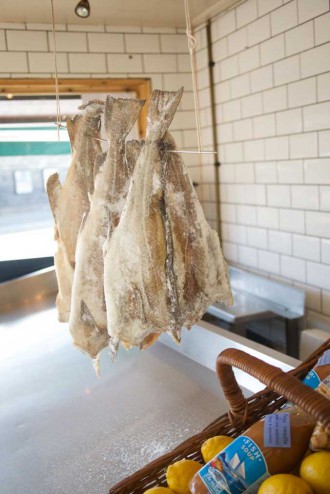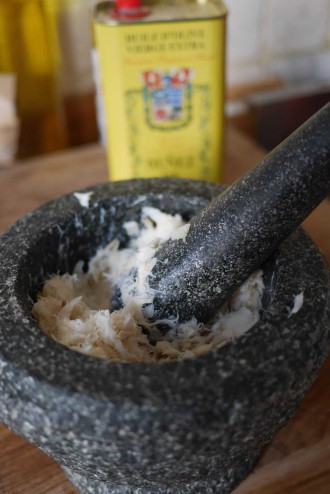Worth waiting for
The salt cod down at Sonny Elliot’s Rockanore fish shop in Hastings has been tantalising me for the last couple of weeks. With all the rain we’ve had, he’s had a struggle to achieve the right conditions for drying out the fish – cold is fine, but the air must be dry to help wick out the moisture, ensuring that the finished product has the right texture and maximising its lifespan.
Each time I pop down there, I ask if it’s ready. And each time, the answer is, not quite. Then finally, this week, after a run of a few sunny days, the cod was good to go.
Enormously popular in southern Europe, salt cod hasn’t really caught on here yet though chefs like Valentine Warner are doing their best to convert us. It’s true that in its salted state it’s nothing to look at – greyish beige, and curled up like an ancient abandoned shoe. Then there’s the smell – distinctly fishy and, as Sonny’s wife Janet pointed out, with a definite undertone of wet dog.
So what’s the attraction? Initially, of course, it was a simple question of preserving protein for use during lean times. The Vikings first dried cod, but it was the Basques who thought of adding salt. The taste for salt cod took hold of the Iberian peninsula to such an extent that the Portuguese word for cod, bacalhau, refers to the salted version rather than the fresh. Bacalhau is synonymous with Portuguese cooking – and perhaps the best known dish is the simple purée of salt cod, garlic and olive oil called brandade.
Inevitably, there are a million different versions of brandade, and as many opinions on how to make it: potatoes vs no potatoes, white wine vs milk for the poaching liquor, food processor vs pestle and mortar. Here’s how we made ours.
Brandade
Enough for 4 as a starter, with some toasted sourdough bread
Ingredients
About 250g salt cod, soaked (I soaked mine for 24 hours in cold water, changing the water 3 or 4 times)
Milk – just enough to cover the cod
A couple of garlic cloves, peeled and squashed with the back of your knife
A few black peppercorns
2 bay leaves
1 medium potato, peeled and sliced
Extra virgin olive oil
Method
Put the milk into a pan big enough to accommodate the fish. Add the garlic, peppercorns and bay leaves, and bring to a simmer. Add the fish, and cook gently until it just flakes. Lift out and leave to cool slightly. Add the sliced potato to the milk and simmer until soft.
When the fish is just cool enough to handle, go through it with your fingers, removing the skin and any bones. Shred it between your fingers.
Drain the cooked potato, reserving the milk, and mash thoroughly.
Either purée the salt cod, garlic, olive oil and about 50ml of the milk in a food processor, or pound in a pestle and mortar (those who advocate doing it the hard way swear the result is fluffier when the fibres are broken down by hand). Add the resulting purée to the mashed potato and combine. Add a little more milk if it seems too stiff.
Serve as a starter with some good sourdough bread or toast, or try it with a poached egg on top for breakfast.







